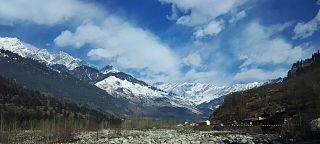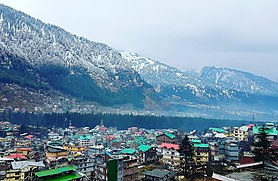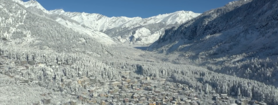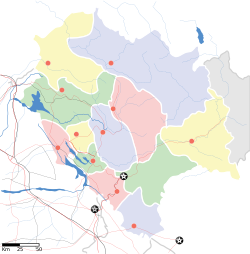Manali, Himachal Pradesh
Manali | |
|---|---|
Clockwise from top: Manali aerial view, Dhauladhar view, Mountains in Manali, Manali after snowfall, River in Manali, Mall road | |
| Coordinates: 32°14′35″N 77°11′21″E / 32.243177°N 77.189246°ECoordinates: 32°14′35″N 77°11′21″E / 32.243177°N 77.189246°E | |
| Country | |
| State | Himachal Pradesh |
| District | Kullu |
| Named for | Manu |
| Elevation | 2,050 m (6,730 ft) |
| Population (2011) | |
| • Total | 8,096[1] |
| • Rank | 22 (state) |
| Languages | |
| • Official | Hindi, Pahadi |
| Time zone | UTC+5:30 (IST) |
| PIN | 175131 |
| Telephone code | +911902 |
| Vehicle registration | HP-58 |
Manali is a town, near Kullu town in Kullu district in the Indian state of Himachal Pradesh.[2] It is situated in the northern end of the Kullu Valley, formed by the Beas River. The town is located in the Kullu district, approximately 270 kilometres (170 mi) north of the state capital of Shimla and 544 kilometres (338 mi) northeast of the national capital of New Delhi. With a population of 8,096 people recorded in the 2011 Indian census Manali is the beginning of an ancient trade route through Lahaul (H.P) and Ladakh, over the Karakoram Pass and onto Yarkand and Hotan in the Tarim Basin of China. Manali is a popular tourist destination in India and serves as the gateway to the Lahaul and Spiti district as well as the city of Leh in Ladakh.[3]
History[edit]
Manali is named after the Sanātanī lawgiver Manu (see Manusmriti). The name Manali is regarded as the derivative of Manu-Alaya (transl. 'the abode of Manu').[4] In Hindu cosmology, Manu is believed to have stepped off his ark in Manali to recreate human life after a great flood had deluged the world. The Kullu Valley in which Manali is situated is often referred to as the "Valley of the Gods". An old village in the town has an ancient temple dedicated to the sage Manu.[5]
Geography[edit]

Manali is located at 32.2396 N, 77.1887 E, about 547 km (340 mi) north of New Delhi.
Demographics[edit]
Manali has grown from a trading village to a small town. As of the 2011 census of India, its population was 8,096. In 2001, Manali had an official population of 6,265. Males constituted 64% of the population and females 36%. Manali had an average literacy rate of 74%, male literacy was 80%, and female literacy was 63.9%. 9.5% of the population was under six years of age.[6]
Weather[edit]
Manali features a subtropical highland climate (Cfb) with warm summers, relatively cold winters, and a high diurnal temperature variation. The temperatures range from −7 °C (19 °F) to 30 °C (86 °F) over the year with the hottest day crossing 30 °C (86 °F) and the coldest day going below −7 °C (19 °F). The average temperature during summer is between 10 °C (50 °F) to 30 °C (86 °F), and between −7 °C (19 °F) to 15 °C (59 °F) in the winter.
Monthly precipitation varies between 31 mm (1.2 in) in November and 217 mm (8.5 in) in July. On average, some 45 mm (1.8 in) of precipitation is received during winter and spring months, increasing to some 115 mm (4.5 in) in summer as the monsoon approaches. The average total annual precipitation is 1,363 mm (53.7 in). Manali experiences snowfall predominantly between December and the beginning of March.
| Climate data for Manali, Himachal Pradesh (1981–2010, extremes 1968–2011) | |||||||||||||
|---|---|---|---|---|---|---|---|---|---|---|---|---|---|
| Month | Jan | Feb | Mar | Apr | May | Jun | Jul | Aug | Sep | Oct | Nov | Dec | Year |
| Record high °C (°F) | 19.5 (67.1) |
23.5 (74.3) |
27.0 (80.6) |
30.0 (86.0) |
35.0 (95.0) |
33.2 (91.8) |
32.6 (90.7) |
30.6 (87.1) |
29.2 (84.6) |
30.0 (86.0) |
25.6 (78.1) |
21.5 (70.7) |
35.0 (95.0) |
| Average high °C (°F) | 10.8 (51.4) |
12.1 (53.8) |
16.7 (62.1) |
21.7 (71.1) |
24.9 (76.8) |
27.0 (80.6) |
26.9 (80.4) |
25.5 (77.9) |
24.7 (76.5) |
22.0 (71.6) |
17.7 (63.9) |
13.5 (56.3) |
20.2 (68.4) |
| Average low °C (°F) | −1.1 (30.0) |
0.2 (32.4) |
3.0 (37.4) |
6.4 (43.5) |
9.1 (48.4) |
12.8 (55.0) |
15.9 (60.6) |
16.0 (60.8) |
12.2 (54.0) |
6.1 (43.0) |
2.2 (36.0) |
0.2 (32.4) |
6.9 (44.4) |
| Record low °C (°F) | −11.6 (11.1) |
−11.0 (12.2) |
−6.0 (21.2) |
−1.0 (30.2) |
1.0 (33.8) |
4.4 (39.9) |
7.4 (45.3) |
7.0 (44.6) |
3.0 (37.4) |
−1.5 (29.3) |
−5.0 (23.0) |
−10.0 (14.0) |
−11.6 (11.1) |
| Average rainfall mm (inches) | 83.5 (3.29) |
110.4 (4.35) |
156.9 (6.18) |
84.7 (3.33) |
73.5 (2.89) |
73.9 (2.91) |
190.3 (7.49) |
192.1 (7.56) |
113.1 (4.45) |
35.9 (1.41) |
28.1 (1.11) |
55.0 (2.17) |
1,197.4 (47.14) |
| Average rainy days | 5.2 | 7.4 | 8.0 | 5.5 | 5.8 | 6.4 | 12.1 | 13.6 | 7.7 | 2.3 | 1.7 | 2.9 | 78.6 |
| Average relative humidity (%) (at 17:30 IST) | 61 | 61 | 53 | 56 | 61 | 63 | 74 | 76 | 75 | 69 | 61 | 62 | 64 |
| Source: India Meteorological Department[7][8] | |||||||||||||
Transport[edit]
Air[edit]
The nearest airport Kullu–Manali Airport (IATA code KUU) is at Bhuntar town in Kullu. The airport is also known as Kullu-Manali airport and has more than a kilometer-long runway. Air India has regular flights to the airport from New Delhi.
Helicopter taxi service[edit]
Pawan Hans, the Government charter agency, provides heli-taxi service connecting Shimla to Chandigarh, Kullu, Kangra and Dharamshala.[9]
Road[edit]
Manali can be reached from Delhi by national highway NH 1 up to Ambala and from there NH 22 to Chandigarh and from there by national highway NH21 that passes through Bilaspur, Sundernagar, Mandi and Kullu towns. The road distance from Chandigarh to Manali is 310 km (190 mi), and the total distance from Delhi to Manali is 570 km (350 mi). Bus services are available from HRTC (Himachal Road Transport Corporation), HPTDC (Himachal Tourism Development Corporation), and private operators.
Railway[edit]
There is no close railhead available close to Manali. The nearest broad gauge railheads are at Una 250 km (155 mi) away, Kiratpur Sahib 268 km (167 mi), Kalka (275 km (171 mi)), Chandigarh (310 km (193 mi)), and Pathankot (325 km (202 mi)). The nearest narrow gauge railhead is at Joginder Nagar (175 kilometres (109 mi)). The Kalka–Shimla Railway is a nostalgic narrow-gauge route culminating at the state capital of Shimla wherefrom one has to travel by road to Manali.
Environmental concerns[edit]
Manali has witnessed a flurry of activity related to hydroelectric power and tourism. Unplanned and rampant construction has led to severe depletion of forests and pollution of river bodies, along with garbage being disposed of on the side of the mountains. There has been a loss of habitat to various species of fauna, not limited to the Himalayan monal, incidentally the state bird of Uttarakhand.[10]
See also[edit]
- [1]
- Tourism in Himachal Pradesh
- List of hill stations in India
- Mall Road, Manali
- Rohtang Pass, Manali
- Manali tour for couples
Further reading[edit]
- Verma, V. 1996. Gadd of Dhauladhar: A Transhumant Tribe of the Himalayas. Indus Publishing Co., New Delhi.
- Handa, O. C. 1996. Buddhist Monasteries in Himachal Pradesh. ISBN 978-8185182032.
- Penelope Chetwode 1972, 1989 "Kulu: The End of the Habitable World" (ISBN 9788185113203) Time Books International
References[edit]
- ↑ "Manali (Kullu, Himachal Pradesh, India) - population statistics, map, and location". Retrieved 1 August 2014.
- ↑ "Wanderlust the mountains are calling head over to Manali, Himachal Pradesh". theindianexpress.com.
- ↑ Paper also Presented at the International Seminar on Disasters, Environment and Development, 9–12 December 1994, New Delhi, India –by James S. Gardner (1995). Tourism and Risk from Natural Hazards: Manali, Himachal Pradesh, India. Natural Resources Institute, University of Manitoba.
- ↑ "History | District Kullu | India". Retrieved 23 November 2022.
- ↑ "Manali Tourism, Himachal Pradesh". India Thrills. Retrieved 26 November 2022.
- ↑ "Census of India 2001: Data from the 2001 Census, including cities, villages, and towns (Provisional)". Census Commission of India. Archived from the original on 16 June 2004. Retrieved 1 November 2008.
- ↑ "Station: Manali Climatological Table 1981–2010" (PDF). Climatological Normals 1981–2010. India Meteorological Department. January 2015. pp. 469–470. Archived from the original (PDF) on 5 February 2020. Retrieved 15 February 2020.
- ↑ "Extremes of Temperature & Rainfall for Indian Stations (Up to 2012)" (PDF). India Meteorological Department. December 2016. p. M69. Archived from the original (PDF) on 5 February 2020. Retrieved 15 February 2020.
- ↑ "Shimla-Chandigarh helicopter service now operating six days a week". Himachal Tourism Official Website. 19 March 2019. Retrieved 21 November 2019.
- ↑ Azad, Shivani (18 November 2019). "Uttarakhand's state bird monal to be conserved with help from Himachal". The Times of India. Retrieved 1 March 2021.










